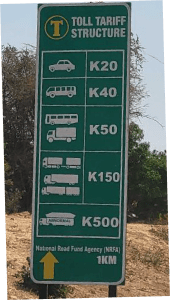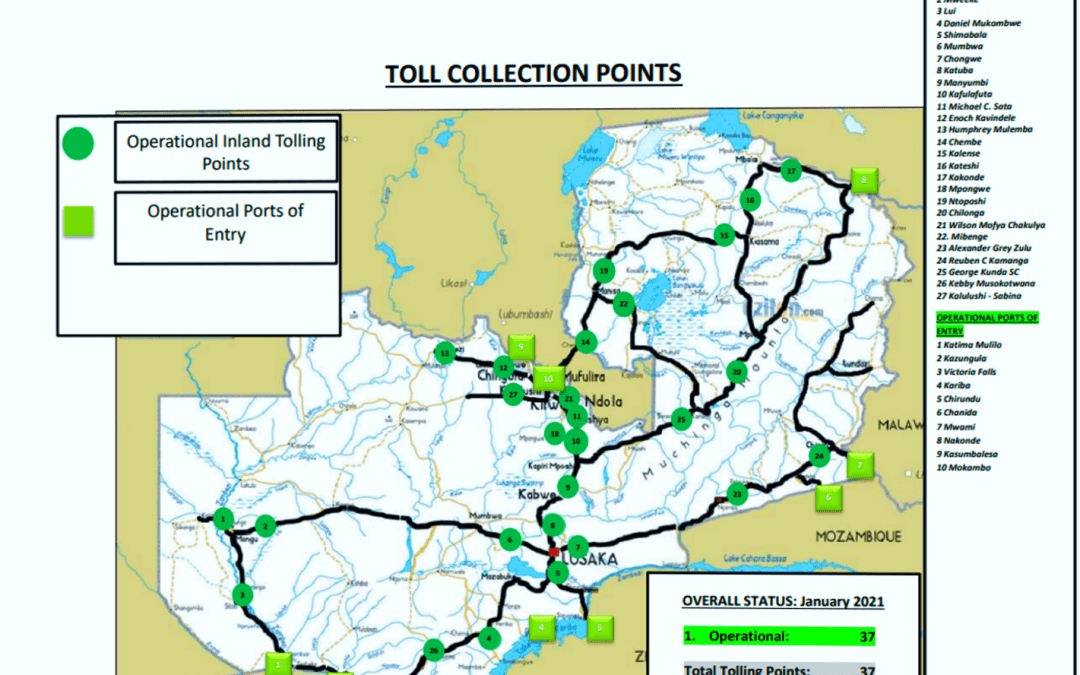BACKGROUND
By ordering the collection of road tolls at designated Weighbridges from all heavy goods trucks, the Tolls Act No. 14 of 2011’s provisions, which began the National Road Tolling Program (NRTP) on November 1, 2013, went into effect.
The Road Development Agency (RDA) was in charge of toll collection from November 2013 to the end of December 2015. The RDA designated the National Road Fund Agency (NRFA) as the Lead Tolls Agent on September 1st, 2015, to manage all toll collecting stations around the nation. The first inland toll plazas spanning all vehicle categories opened for business on January 16, 2016, at Manyumbi (between Kabwe and Kapirimposhi) and Kafulafuta (between Kapirimposhi and Ndola).
These were temporary toll plazas using the basic booth and boom technology with a highly reduced start-up-cost for the purpose of raising much-needed revenues to support road maintenance programs.
Effective 1st January 2017, Statutory Instrument No. 85 of 2016 was issued by the Honourable Minister of Housing and Public Infrastructure which revised toll tariffs and also introduced value propositions such as the Local User Discounts (LUDs) and Frequent User Discounts (FUDs) to improve the experience of toll payers on toll facilities, as regards affordability and equity of road use.
In May 2017, the first conventional toll plazas were commissioned by His Excellency the President of the Republic of Zambia Mr Edgar Chagwa Lungu, at three toll stations namely Katuba Toll Plaza ( on T2 between Lusaka and Chisamba) and at Shimabala Toll Plaza (on T2 between Lusaka and Kafue) and at Mumbwa Toll Plaza (M9 between Lusaka and Mumbwa).
Currently, the Inland Toll Stations stand at 27 and it is envisioned that the Agency will expand the Road Tolling footprint to 40 Toll Stations across the country of different types according to Traffic Volumes.
| CLASS | DESCRIPTION | RATE | AMOUNT (ZMW) |
| (a) | Small vehicles (including cars, vans and minibuses up to 15 seats) (Single Access) GVM <3,500Kg | Fixed | 20 |
| (b) | Minibuses (16-30 seats) Single Access) including light Trucks with 3,500Kg <GVM>6,500Kg | Fixed | 40 |
| (c) (d) | Buses above 30 seats (Single Access) Light Trucks and with 2-3 Axles and GVM>6,500 Kg single access | Fixed | 50 |
| (e) | Heavy vehicles with articulated semi-trailer -4 Axles (Single Access) | Fixed | 150 |
| (f) (g) | Heavy trucks with articulated semitrailer –above 4 Axles (Single Access) Heavy vehicles interlink –above 6 Axles (Single Access) | Fixed | 150 |
| (h) | Abnormal loads (Single Access) | Fixed | 500 |

OPINION
It is impossible to overstate the importance of having a good road network as a valuable economic asset. Roads facilitate growth, and the ease with which people may move from one location to another serves as a measure of development. Yet, highways don’t merely appear over time like bushy village walks. They now rank among the most costly infrastructure projects a nation can undertake. For the last ten years, our nation has spent millions of dollars building highways.
As at today 24th January 2023, there are 37 toll gates in Zambia, each serving as a a paypoint for roadusage under the National Road Fund Agency – NRFA. Under legislative instrument No. 73, toll gates were established in 2013 with the express purpose of using the funds raised for road upkeep and construction. We recall the outcry from the public when this law was implemented because they believed the government was overtaxing them, but gradually road tolls were viewed as a positive development in the expectation that our roads’ condition would improve. However, this is not exactly what we have seen since then, because money collected through road tolls was diverted to serve other purposes.
The government received K6.3 billion from 37 toll gates located around the nation between 2016 and 2021, according to figures provided to Parliament by Minister of Finance and National Development Dr. Situmbeko Musokotwane last year. It is uncertain to determine how much of this money was really used to upgrade roads.
Due to this, the Parliamentary Committee on Transport, Works, and Supplies suggested that only road construction, rehabilitation, and maintenance projects be funded by toll gate revenue. The recommendation was made by the committee’s chair, Mr. Mubika Mubika, during a presentation of a report to Parliament.
He said that policies should be put in place to guarantee that the money collected at toll booths is used to expand the road system.
In fact, we think that using the proceeds from tolls on the roads will ultimately save the government a lot of money since timely road maintenance will be possible rather than waiting until potholes turn into craters. Citizens won’t need to wait until the next election cycle for road repairs if the government uses the money obtained from toll roads for the intended purpose. We implore the government to take action right away.

